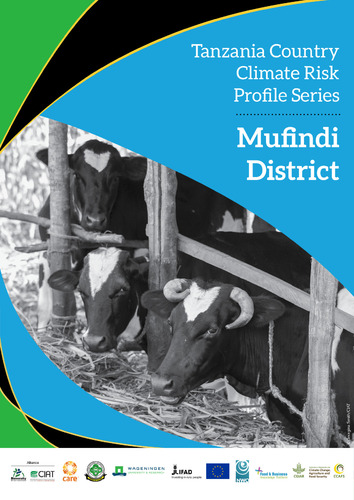Tanzania Country Climate Risk Profile Series, Mufindi District
The agricultural sector in Tanzania is facing high climatic risks. Frequent and severe temperature and precipitation, recurrent droughts and increased incidences of pests and diseases are some of the climate effects that have been observed. Catalyzed with rising input prices and price volatility, there has been a decline in food productivity and farmer incomes. The natural resources that support agricultural production—including rivers and forests—are also degrading due to extreme climate events. Projections indicate that these trends are likely to worsen in the coming decades, with temperatures increasing by nearly 2.7°C by
and 4.5°C by 2060 and 2090 respectively (Irish Aid , 2018). At the same time, both day and night temperatures will become more extreme, and precipitation will begin to vary more dramatically by geographic area. Smallholder farmers are particularly vulnerable to the effects of climate change because of their low access to the resources needed to adapt to changing conditions. Among smallholders, women are more vulnerable due to their outsized role in agriculture and the social limitations placed on their decision-making and inclusion. A lack of coordination and information symmetry between stakeholders have prevented the full implementation of policies aimed at mitigating climate change. The government, with the support of development partners, has put in place a number of policies, strategies and guidelines to address climate change. The National Agriculture Policy (2013), National Climate Change Strategy (2012), National Adaptation Programme of Action (2007), and the Climate Smart Agriculture guideline (2007) provide a framework for creating agricultural resiliency in the face of climate change. This Climate-Smart Agriculture (CSA) Profile documents the need for, and adoption of CSA practices at the local level in Mufindi District. This profile is an output of the CSA/SuPER project on Upscaling CSA with Small-Scale Food Producers Organized through Village Savings and Lending Associations (VSLA). The project is implemented by Cooperative Assistance and Relief Everywhere (CARE)
International, the International Center for Tropical Agriculture (CIAT) (now part of the Alliance of Bioversity International and CIAT), Sokoine University of Agriculture (SUA), and Wageningen University and Research (WUR). Both qualitative and quantitative methods were used to gather the information herein, in accordance with the methodology employed by Mwongera et al. (2015). Secondary information was collected through an extensive literature review. Primary information was collected from
interviews with agricultural experts, farmer focus group discussions, stakeholder workshops, and farmer interviews in the Mufindi District. This profile is organized into six major sections based on the analytical steps of the study. The first section describes the
contextual importance of agriculture to Mufindi livelihoods and households. The second describes historic and future climatic trends. The third section highlights farmers’ priority value chains. The fourth section addresses the challenges and cross-cutting issues in the sector. The fifth section details climate hazards experienced by farmers, as well as the current and proposed adaptation strategies. Finally, the sixth section outlines the policies related to CSA and the institutions that facilitate implementation of climate change initiatives.

